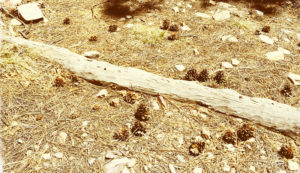 E S S A Y If you’re not looking down when hiking, you either have super powers or you fall a lot. The point is you’re constantly thinking about where you are going in order to plant the next step and the step after that, and the step after that. The trail could be rocky, muddy, sandy or covered in pine needles (my favorite), but you need to be looking down and making hundreds (maybe thousands) of split second decisions about where to plant your feet.
E S S A Y If you’re not looking down when hiking, you either have super powers or you fall a lot. The point is you’re constantly thinking about where you are going in order to plant the next step and the step after that, and the step after that. The trail could be rocky, muddy, sandy or covered in pine needles (my favorite), but you need to be looking down and making hundreds (maybe thousands) of split second decisions about where to plant your feet.
With all that concentration focused on remaining upright, it can be easy to miss nature’s feng shui efforts along the trail. You will encounter a log or root that crosses the trail at an angle with pine cones or rocks placed strategically in just the right position. You might see a natural step carved from a rock ledge that traverses the path. Even treefalls that block the trail have a natural symmetry that is unmistakably nature’s handiwork.
When viewed on a map, the entire trail can be an example of feng shui in that it conforms to the slope and topography of the land. Hiking trails were usually constructed with a nod towards finding the easiest line or axis. Given feng shui’s history as a forerunner of the magnetic compass, it makes perfect sense that there’s a real astronomical connection between the trail and the stars.
The English translation of feng shui is “wind-water” and both of these elements have a significant impact on the appearance of a hiking trail. Drainage erosion has created new trails and rerouted old trails, while wind blown sand covers up the path or forces the hiker to find a new line or route.
Is feng shui science or mystical pseudoscience? It doesn’t matter to the hiker who just wants to take the correct line or the right steps. Humans may create the trails but nature, and by extension feng shui, performs most of the upkeep. All we can do is try to take the right steps and be on the lookout for millions of feng shui examples one might see on any given hike.
It shouldn’t be that hard to see them. You are looking down at your feet for most of the hike.
Jay Harrison is a graphic designer and writer whose work can be seen at DesignConcept. His mystery novel, Head Above Water, is available on Amazon and Kindle.